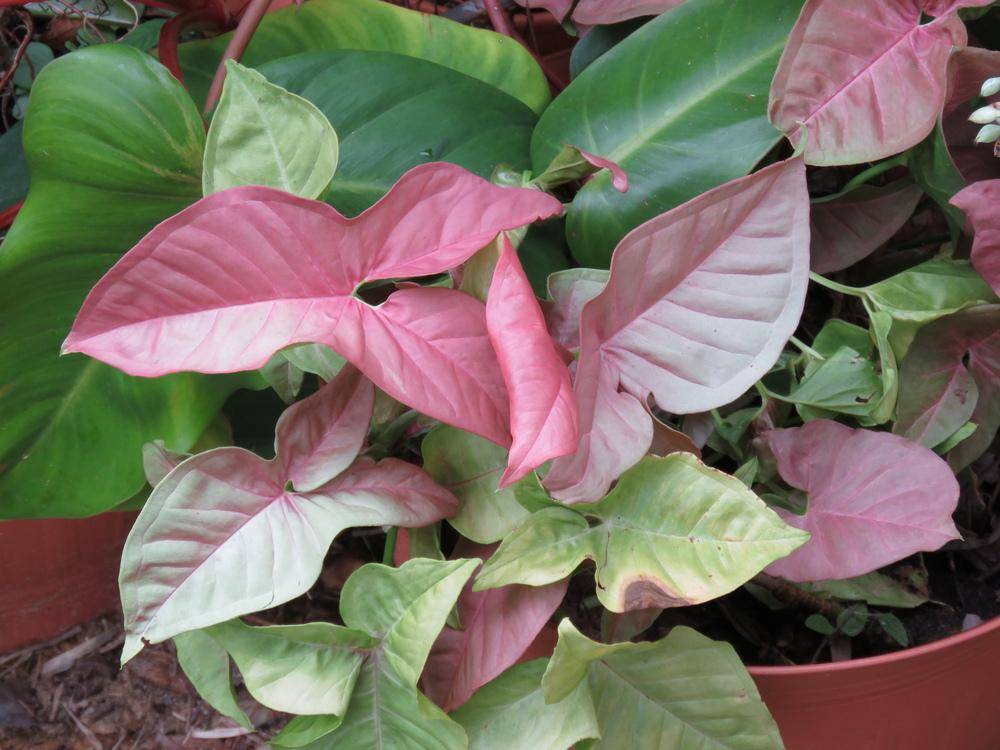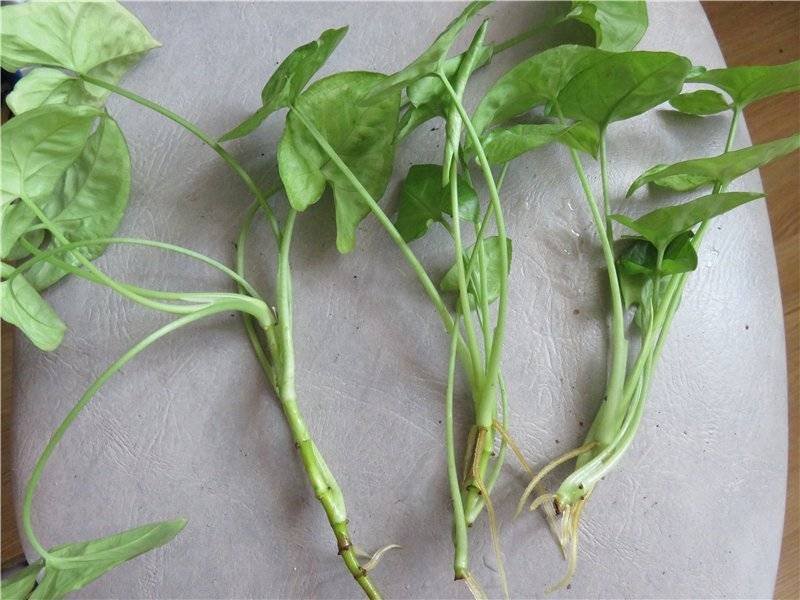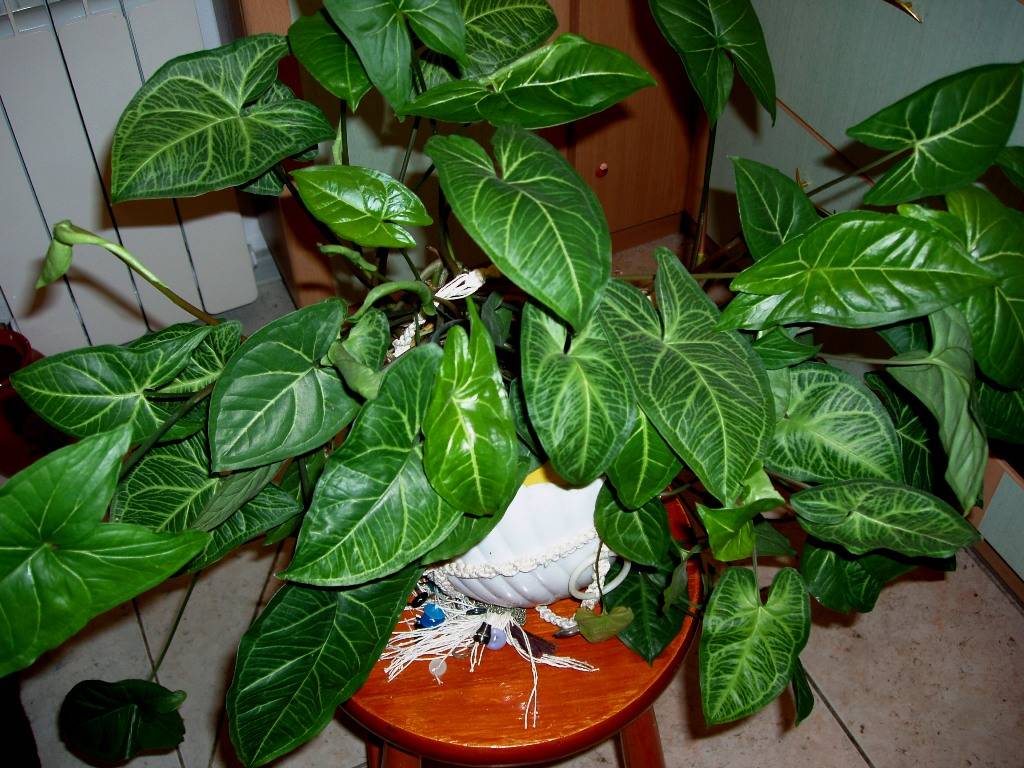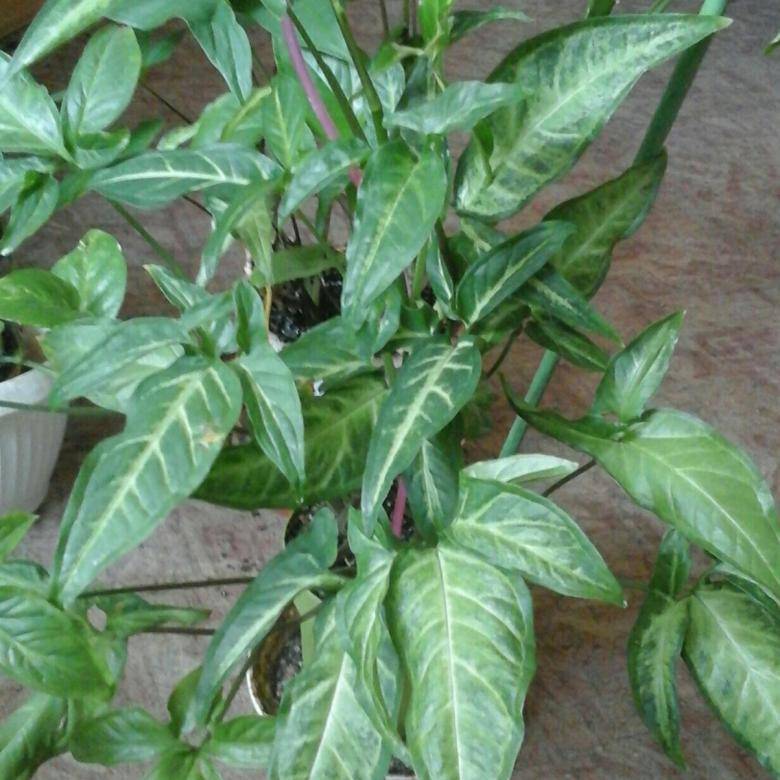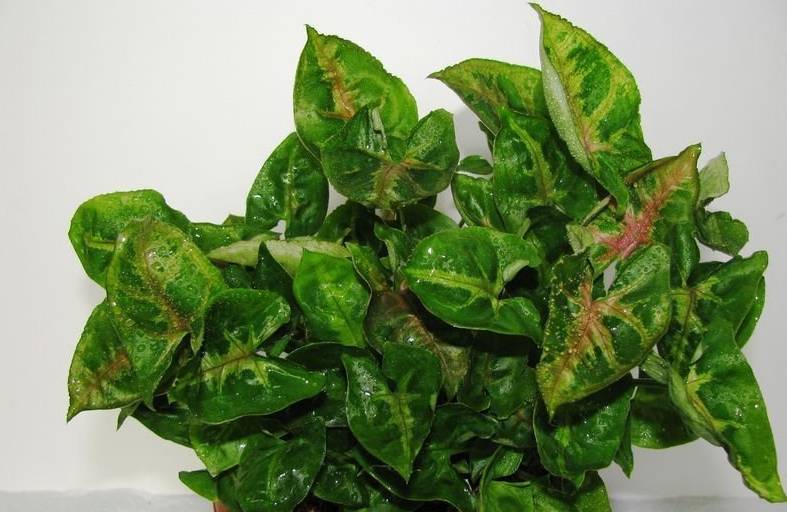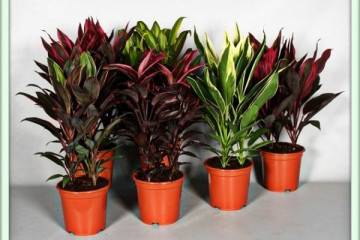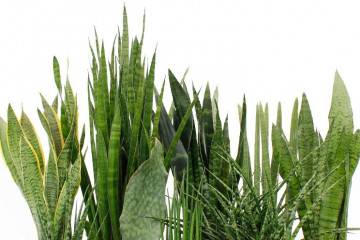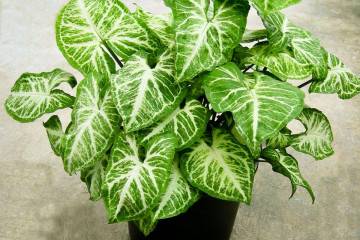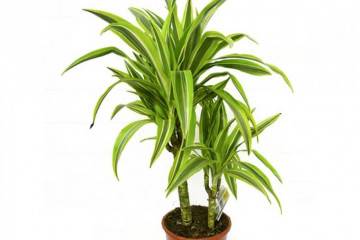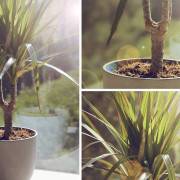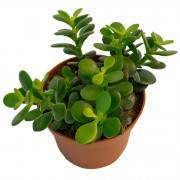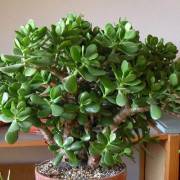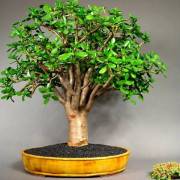Syngonium flower - species and varieties, how it blooms
Content:
Plant forecaster - this is how the syngonium flower is called, thanks to its ability to absorb moisture from the air and form droplets of water on the foliage, foreshadowing the approaching rain. Florists love perennials because of its showiness and variety of colors.
Syngonium: description, structural features, distribution
The genus Syngoniums are evergreen perennial herbaceous plants belonging to the Aroid family. The name is translated from Latin as "united ovule". They weave and develop like tropical vines.
They are popular indoor plants, close relatives of monstera, spathiphyllum, philodendron, dieffenbachia.
Root
Thanks to a powerful system of nourishing and aerial roots, the syngonium grows and develops rapidly. At home, its growth is 30-50 cm per year.
The feeding roots are fibrous, located in the ground and at the stem nodes. They are dense and serve to provide nutrients and water. The underground root system is powerful. It develops rapidly in light, loose, oxygen-rich soil with neutral acidity. The underground roots quickly fill the flowerpot. The flower is transplanted once every 2 years with the onset of spring.
Shortened air roots, located on the stem. They hold the syngonium on the surface of the earth or on various supports.
In heavy soil, the roots grow moldy and rot. They are sensitive to excess moisture, therefore drainage equipment is an important factor in the normal development of the bush. In waterlogged soil, the root system first deteriorates, then the stems may disappear and the leaves may turn yellow. To save the flower, it is transplanted into a clean substrate.
Stem
If you pinch the top of the stem, the flower gives lateral root shoots. This is the formation of a lush beautiful bush.
In young bushes, the shoot is green, flexible, participates in photosynthesis and has a diameter of 1-2 cm. The length of the stem of an adult flower reaches 20 meters. With age, it acquires a woody structure and color, ceases to be flexible. Its diameter reaches 6 cm.
The damaged stem on the cut gives off a milky sap. It is poisonous: it causes redness, a rash on the human body, and burns on the mucous membranes. If it enters the stomach, it provokes food poisoning.
When artificially grown, the syngonium liana reaches 2 meters in height. To hold it in an upright position, use the supports:
- ladders,
- columns with moss,
- wooden sticks.
Internodes with aerial roots and long leafy cuttings are formed on the stem. If you cut off a piece of stem with 2-3 internodes and put it in water with charcoal, then after a week, roots will develop on it. Thus, the propagation of the flower by stem cuttings occurs.
Leaves
The flower is evergreen. With the arrival of a cold snap, it does not lose its color brightness and does not fall off.The color of the leaf plate ranges from light cream to dark green or chocolate red. Solid colors are rare. They often have a peculiar spotted-mesh pattern.
The shape of the leaf plate is: heart-shaped, spear-shaped, with lobes. Adult plants change the shape of the plate, forming from 3 to 7 segments on it. Its color, size, shape, surface depend on the variety, amount of light and mineral fertilizers.
Dry, hot air in a room causes a lack of moisture. The tips of the leaf plates become dry. The lack of nutrients in the soil also affects the state of the foliage: it becomes smaller, becomes yellow, and dries up. Syngonium does not like exposure to direct sunlight. Prolonged exposure to the sun reduces the brightness of the color of the leaves. They become shallow and pale.
Flower
In its natural environment, the syngonium throws out a light cream or yellow flower-cob with a pinkish hood, which blooms for 2-3 days. After pollination by insects, a fragrant fruit is formed with up to 100 seeds. Tropical animals and birds eat the fragrant cobs and carry seeds over long distances.
Indoor syngonium bloom is extremely rare. This usually happens if you take proper care of it.
The plant needs the following conditions:
- penumbra;
- lack of direct sunlight;
- air temperature - 18-25 ° C;
- loose light soil;
- proper feeding and watering;
- high air humidity;
- protection against diseases and pests.
But even if these rules are followed, the florist may not get the desired result and the question of why he does not bloom will remain open.
Spread
The natural habitat of lianas is the climate of the subtropics or tropics of Latin America, Cuba, Jamaica, Haiti. In this part of the American continent, there are up to 30 species. She loves shady rainforests.
Relatively recently, syngonium was introduced to the Russian Federation and became a popular decorative flower for growing at home, in offices, and public institutions. It is spectacular, unpretentious, pleases households with bright foliage all year round.
Types and varieties for indoor cultivation
According to the shape of the leaf plate, the syngonium is divided into two types:
- leg-leaved;
- eared.
From them, the breeders bred the rest of the decorative varieties.
Artificially bred syngoniums are sensitive to changes in temperature, humidity, watering and lighting.
Syngonium Knife-leaved
The birthplace of the flower is Central America. It got its name from the shape of the leaves, which resembles a foot. It is also called syngonium Nogolistny or Podophyllum. It has become the most popular among flower growers due to its beauty and easy care.
It has a deep green color with light stripes. Young - glossy, bright, old - dull. Length - 10-20 cm, width - up to 10 cm. Flower stems with a diameter of 1-2 cm, bend well. Numerous branching shoots form a lush beautiful bush up to 100 cm high.
Syngonium Imperial White
It grows and develops slowly. A distinctive feature is bright green large spear-shaped leaves with large white spots of irregular shape. With good lighting and insufficient feeding with mineral fertilizers, it loses its variegation: absolutely whitish leaves appear, which quickly die off. A small amount of sunlight produces a completely green leaf.
The species is unpretentious, takes root well. The shoot branches poorly, so 2-3 bushes are planted in a pot to form a lush flower.
Syngonium Neon Pink
Unusual, beautiful. Cuttings are green with young leaves of a bright pink hue up to 20 cm long. As they grow older, they acquire a green color with pink veins. The bottom of the leaf plate is always green. The surface is smooth, glossy in young and matte in adults.
Short internodes form a compact bush, which does not grow much. For good development, it requires a perfect match between humidity, air temperature and lighting.
Syngonium Eared
Perennial herbaceous flower. Its second name, "ear-shaped syngonium", speaks for itself. Large trifoliate leaves are located on cuttings up to 40 cm long. There is a large main leaf, and on the sides there are two small ones, resembling ears. Large size - up to 20 centimeters. In an adult bush, it divides into three lobes. The sheet plate is smooth, glossy, waxy, saturated green.
The diameter of the shoot is 2-2.5 cm, and the length is up to 2 meters. There are numerous air roots on it. It grows quickly, giving an increase of up to 70 cm per year.
Syngonium Wendland
His homeland is Costa Rica. Forms a small bush no more than 1.5 meters high. It grows slowly. The stem is green, with petioles 10-30 cm long located on it.
In a young flower, the leaves are large, spear-shaped, and in an adult they are divided into 3 lobes. Their length is up to 10 cm. The color is deep green with a silvery streak in the middle. The surface is smooth, shiny, velvety. Inflorescence in the form of a curved ear with a veil that has a reddish tint inside and green outside.
Syngonium Panda
It is still not widely spread among lovers of decorative perennials. It has the shape of a bush with short shoots extending from it. It is distinguished by an interesting color - rich green with bright yellow spots of various sizes and irregular shapes, located chaotically. The surface is matte, smooth. The leaf plate is large, heart-shaped. Its length is 10-20 cm.
Syngonium Pink
It combines several varieties that are distinguished by an amazing color: from light pink to almost red. It mixes with green, yellow colors, forming beautiful streaks. The leaflets are spear-shaped or heart-shaped. The underside is usually green.
The most interesting varieties:
- Syngonium Red Spot combines three colors in different variations. It is pink, green and milky.
- Regina Red has a bright pink color on top of the plate and green on the bottom. In poor lighting, colors fade.
- Red Hart - muted matte pink color, grows slowly, forms a bush.
- Syngonium Mango Allusion - has a characteristic pink mesh on a green background.
- Neon Tetra is a very bright saturated rose bush, capricious in growth and content.
- Pink Fleskid - has green and yellow spots on a pink background, is rare, loses color with the slightest change in content factors.
- Syngonium Pink Splash - has a heart-shaped leaf plate. It is bright green with small, weakly expressed pink blotches. It bushes and reproduces poorly.
Syngonium Confetti
It has a very unusual color: on a light green background, small bright pink splashes-spots of irregular shape. One spot can occupy up to half of the leaf surface, the shape of which depends on age. Juveniles are unsected, arrow-shaped, bright, shiny, adults are dull, faded, with five pronounced lobes resembling an irregular star.
Syngonium Butterfly (or Butterfly)
Its height is up to 1.5 meters. It grows quickly, unpretentious. The plate is spear-shaped with a branched network of thin veins. Its size is 8-15 cm. The color is from sandy to dark green with pinkish veins.Old plates acquire a monochromatic whitish color. The surface is smooth and shiny.
It grows well, curls, propagates by cuttings. Sensitive to soil nitrogen content. The most popular varieties are called White and Alluzhne.
Syngonium Tiffany
A compact bush no more than 1 meter high. Shoots 1-1.5 cm thick, often with low cuttings with dark green leaves. They have a wide pink streak in the center. The shape is heart-shaped, the length is 5-8 cm, the surface is smooth, shiny. Thanks to small sheet plates, it takes up little space on the windowsill, table, in any room. The compact bushes also include the Pixie syngonium.
Syngonium Macrophyllum
Tall, fast-growing with large pointed matte leaves. Solid green color.
Syngonium Christmas
Combines green and yellow with pink veins. Foliage slightly corrugated at the edges.
The beauty, uniqueness of the forms and colors of the syngonium cause genuine admiration for flower growers. Each of them is trying to acquire a new unusual variety of this vine, which becomes the pride of his collection.
